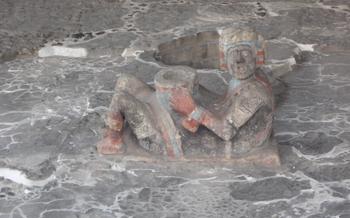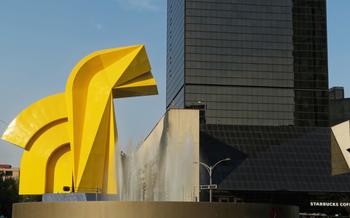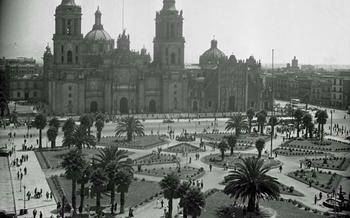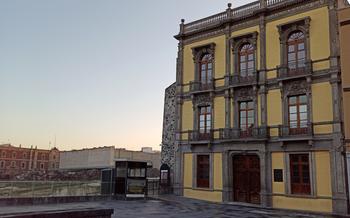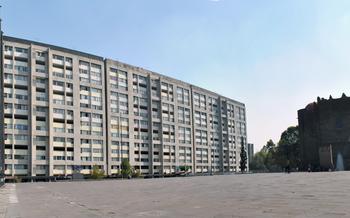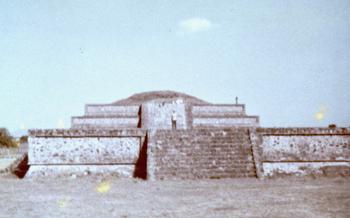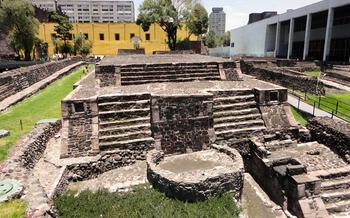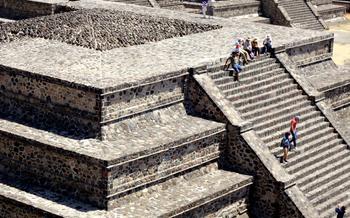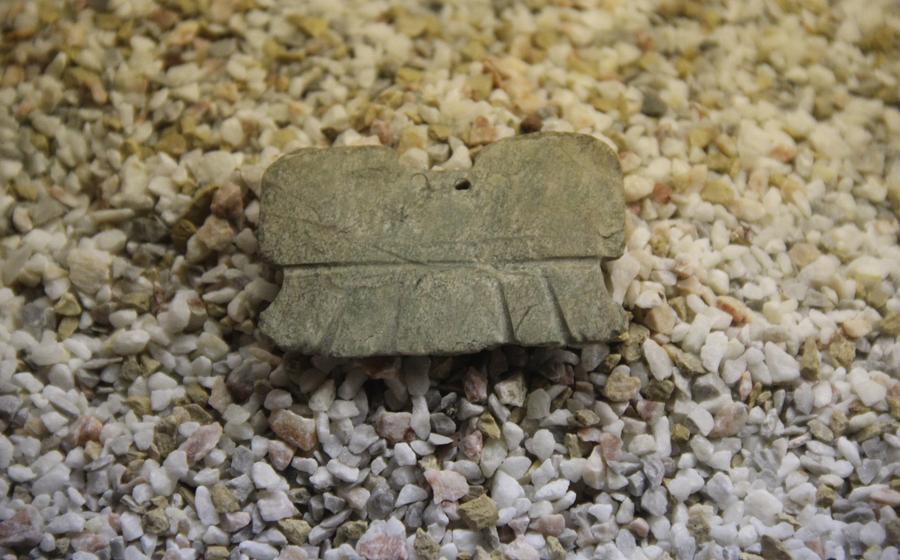
The Great Temple (Templo Mayor)
- Architectural features
- Exploring the Archeological Site
- The Museum on-site
- Ceremonial Center and Urban Planning
- Cultural and Historical Context
- Practical Information
- Guided Tours and Local Guides
- Combining History and Nature
- The Great Temple and Mexican Identity
- Unveiling Ancient Mysteries
- Documenting Your Visit
- Insider Tip: Off-the-Beaten-Path Experiences
Architectural features
The Great Temple of Tenochtitlan, also known as the Templo Mayor, is a remarkable architectural masterpiece that embodies the grandeur and sophistication of the Aztec civilization. Constructed in the 14th century, this awe-inspiring structure served as the religious and political center of the Aztec empire.
The Great Temple consists of a series of superimposed platforms, each adorned with intricate carvings and sculptures that reflect the Aztec's profound understanding of astronomy, religion, and mythology. The temple's distinctive double staircase, flanked by towering serpents, leads to the main platform, where two shrines dedicated to the gods Huitzilopochtli and Tlaloc once stood.
The temple's architectural design is a testament to the Aztecs' engineering prowess. Using only basic tools and materials, they managed to construct a massive structure that could withstand earthquakes and support the weight of thousands of worshippers. The Great Temple's impressive design and construction techniques continue to captivate and inspire visitors to this day.
Exploring the Archeological Site
The archeological site of Teotihuacan offers a captivating journey through the remnants of an ancient city. The layout of the site is centered around the Great Temple (Templo Mayor), with vast plazas, ceremonial platforms, and residential compounds radiating out from it. Among the major structures, the Pyramid of the Sun and the Pyramid of the Moon stand as testaments to the city's architectural prowess, serving as ceremonial and astronomical centers. Other significant structures include the Ciudadela, a large complex with a central plaza and smaller pyramids, and the Avenue of the Dead, a grand thoroughfare connecting the main ceremonial precincts. Excavation and restoration efforts have been ongoing for decades, unearthing new discoveries and shedding light on the city's history and culture. Visitors can explore the site on foot or take advantage of guided tours to delve deeper into the fascinating world of Teotihuacan. Accessibility is well-catered for, with paved paths, ramps, and designated areas for visitors with disabilities.
The Museum on-site
The on-site museum at Teotihuacan offers visitors a comprehensive look into the history and significance of the ancient city. Inside the modern and well-curated museum, visitors will find a treasure trove of artifacts and exhibits that provide insights into the lives and beliefs of the Teotihuacan people.
The museum's collection includes a vast array of artifacts, such as pottery, obsidian tools, jewelry, and sculptures, that offer a glimpse into the daily lives and craftsmanship of the city's inhabitants. Visitors can also admire intricately carved stone panels and murals that once adorned the temple's walls, providing a visual testament to the artistic and cultural achievements of the Teotihuacan civilization.
In addition to artifacts, the museum provides historical context and explanations that help visitors understand the significance of the temple and the city. Informative panels, interactive displays, and educational programs shed light on the religious beliefs and practices of the Teotihuacan people, as well as the role that the temple played in their urban planning and social structure.
Guided tours and audio guides are available for those who wish to delve deeper into the history and symbolism of the site. These tours provide expert insights and explanations that bring the ancient city and its people to life, offering visitors a truly immersive and educational experience.
Ceremonial Center and Urban Planning
The city of Tenochtitlan, where the Great Temple stood, was a marvel of urban planning and engineering. The city was built on an island in Lake Texcoco, with a system of canals and causeways connecting it to the mainland. The city was divided into four quadrants, each with its own temples, markets, and residential areas. The Great Temple was located in the center of the city, symbolizing its religious and political importance.
The urban design of Tenochtitlan was influenced by the Aztec worldview. The city was laid out in a grid pattern, with wide avenues and plazas. The streets were oriented towards the cardinal directions, and the city was surrounded by a wall. The city's layout reflected the Aztec belief in order and harmony.
The ceremonial center of Tenochtitlan was a sacred space where religious rituals and ceremonies took place. The Great Temple was the most important structure in the ceremonial center, and it was used for human sacrifices and other religious ceremonies. The ceremonial center was also used for political gatherings and other important events.
The relationship between the city and the temple was one of interdependence. The city provided the resources and manpower necessary to build and maintain the temple, while the temple provided the religious and political authority that legitimized the city's rule. The Great Temple was the heart of Tenochtitlan, and it played a vital role in the city's life and culture.
Cultural and Historical Context
The Great Temple was the religious and ceremonial heart of the Aztec capital, Tenochtitlan, and played a crucial role in the cultural and spiritual life of the Aztec civilization. The Aztecs, or Mexica, were a Mesoamerican people who dominated the central region of Mexico from the 14th to the 16th century. They were skilled in agriculture, engineering, astronomy, and mathematics, and their culture was rich in mythology, religion, and art.
The Aztecs believed in a complex pantheon of gods and goddesses, each with specific powers and responsibilities. The Great Temple was dedicated to their two main deities, Huitzilopochtli, the god of war and the sun, and Tlaloc, the god of rain. The temple was the site of numerous religious ceremonies, including human sacrifices, which were believed to be necessary to appease the gods and ensure the continued fertility of the land.
The Aztecs also believed that the Great Temple was the center of the universe and that it marked the spot where the gods created the world. The city of Tenochtitlan was built around the temple, and its layout was designed to reflect the Aztec cosmovision. The city was divided into four quadrants, each associated with a different direction and element, and the Great Temple was located at the center, symbolizing the unity of the universe.
The fall of Tenochtitlan and the Spanish conquest in the 16th century marked the end of the Aztec civilization. The Great Temple was destroyed by the Spanish conquistadors, and the city of Tenochtitlan was rebuilt as Mexico City. However, the temple's ruins have survived and continue to be a source of fascination and inspiration for people worldwide.
Today, the Great Temple is considered a symbol of Mexican identity and a testament to the ingenuity and artistry of the Aztec civilization. It is a popular tourist destination, and millions of visitors come to see the ruins and learn about the history and culture of the Aztecs.
Practical Information
Visiting the Great Temple of Tenochtitlan requires careful planning to ensure a smooth and enjoyable experience.
-
Entrance fees and ticketing: The entrance fee for the archeological site and the on-site museum is generally affordable, catering to both domestic and international visitors. Various ticket options are available, including individual tickets, family packages, and discounts for students and seniors. Advance purchase of tickets online or at designated ticket offices is recommended to avoid long queues, especially during peak tourist seasons.
-
Opening hours and days of operation: The Great Temple is open to the public daily, with extended hours during the summer months. It is advisable to check the official website or contact the visitor center for the most up-to-date information on opening hours and any temporary closures due to maintenance or special events.
-
Getting to the site by public transportation: The Great Temple is conveniently accessible by public transportation. Several metro lines and bus routes stop within walking distance of the site. Detailed instructions and maps are available online or at tourist information centers.
-
Parking options and accessibility: Limited parking is available near the archeological site, but it can be challenging to find a spot during busy periods. Alternative options include using public transportation, taxis, or ride-sharing services. The site is generally wheelchair accessible, with ramps and designated pathways for visitors with disabilities.
Guided Tours and Local Guides
When visiting the Great Temple, it is highly recommended to hire a professional tour guide to enrich your experience and gain a deeper understanding of the site's history and significance. These knowledgeable guides can provide insights into the temple's architecture, religious rituals, and the lives of the Aztec people.
There are various types of guided tours available, ranging from general overviews to specialized tours focusing on specific aspects of the site. Choose a reputable tour operator that offers experienced and certified guides to ensure a high-quality experience.
To make the most of your tour, arrive a few minutes early to ask your guide any questions you may have. Be sure to wear comfortable shoes as the tour involves a fair amount of walking. Also, bring a camera to capture the stunning views and intricate details of the temple.
If you prefer a more personalized experience, consider booking a private tour. This option allows you to tailor the tour to your specific interests and preferences, ensuring a truly memorable and immersive visit to the Great Temple.
Combining History and Nature
Teotihuacan is not just about ancient ruins; it's also surrounded by natural beauty that complements the historical significance of the site. The Cerro Gordo Ecological Park offers stunning views of the pyramids and the surrounding countryside. Visitors can hike, bike, or simply relax amidst the serene landscapes.
Another nearby attraction is the Butterfly Garden, home to a wide variety of colorful butterflies that flutter around the vibrant flowers. Explore the Cactus Garden, showcasing a diverse collection of cacti and succulents from the region. These natural attractions provide a welcome respite from exploring the ancient city, allowing visitors to immerse themselves in the beauty and diversity of Mexico's natural heritage.
Combine your visit to the Great Temple with a trip to the San Juan Teotihuacan Market. This vibrant marketplace offers a glimpse into the daily lives of locals and is a great place to find souvenirs, handicrafts, and traditional Mexican cuisine.
Create a well-rounded and enriching experience by blending the exploration of ancient history with the appreciation of nature's wonders. Teotihuacan has something to offer every traveler, whether you're a history buff, nature enthusiast, or simply seeking a unique and memorable experience.
The Great Temple and Mexican Identity
The Templo Mayor stands as a national symbol, a testament to the rich history and cultural heritage of Mexico. For Mexicans, it represents a deep connection to their ancestral roots, a reminder of the ingenuity and achievements of their forebears. The temple's grandeur and history evoke a sense of national pride and identity, symbolizing the resilience and strength of the Mexican people.
Throughout the year, the Templo Mayor serves as a backdrop for various cultural events and celebrations, showcasing the vibrant traditions and folklore of Mexico. The annual Festival del Templo Mayor is a prime example, bringing together artists, performers, and locals to commemorate the temple's significance through music, dance, and cultural exhibitions. These events not only honor the past but also foster a sense of community and cultural appreciation among Mexicans, perpetuating the temple's role as a symbol of unity and national identity.
Unveiling Ancient Mysteries
The Great Temple of Tenochtitlan has captivated the world with its grandeur and historical significance. However, beyond what is visible to the naked eye, the site continues to yield secrets that unravel the enigmas of ancient civilizations. Ongoing archeological research at the Templo Mayor sheds light on the intricate details of Aztec life, culture, and religious practices.
Archeologists meticulously excavate the site, uncovering artifacts that provide valuable insights into the past. These discoveries range from ceramic vessels and obsidian tools to intricate sculptures and jewelry, each revealing a piece of the puzzle that is the Aztec civilization.
The Templo Mayor is not merely a monument but a gateway to understanding the cultural heritage of Mexico. By preserving and studying this site, we not only honor the legacy of the Aztecs but also gain a deeper appreciation for the complexities of Mesoamerican civilizations.
The challenges in archeological research are numerous. The passage of time, natural disasters, and human intervention have left their mark on the site. However, the dedication of archeologists and the support of organizations committed to preserving cultural heritage ensure that the mysteries of the Templo Mayor continue to be revealed.
The continuous uncovering of ancient treasures at the Templo Mayor reminds us of the importance of preserving our cultural heritage. It is through these archeological endeavors that we gain a deeper understanding of our past and forge a connection with the civilizations that shaped our present.
Documenting Your Visit
As you embark on your journey through the ancient city, don't forget to document your experience through the lens of your camera. The Templo Mayor offers a plethora of opportunities for capturing stunning photographs that will serve as lasting mementos of your visit. With its imposing structures, intricate carvings, and sweeping vistas, the archeological site provides a picturesque backdrop for your photography.
Seek out vantage points that allow you to capture the grandeur of the Great Temple. The panoramic views from the top of the Pyramid of the Sun offer a breathtaking perspective of the entire complex, while the close-up shots of the intricate carvings on the temple walls reveal the artistry and craftsmanship of the ancient builders.
For Instagram enthusiasts, the Templo Mayor offers an array of Insta-worthy spots. Capture the iconic image of the temple against the backdrop of the setting sun, or experiment with creative angles to showcase the unique architectural features of the site. Don't forget to share your photos with the world using relevant hashtags and captions that provide historical context and personal insights.
Through the art of photography, you can not only document your visit but also contribute to preserving the memory and legacy of this ancient site. Your images may inspire others to embark on their own journey of discovery and appreciation for the wonders of the Templo Mayor.
Insider Tip: Off-the-Beaten-Path Experiences
Venture beyond the main tourist areas to discover the hidden gems of Teotihuacan. Explore the surrounding neighborhoods, where you can interact with local artisans and craftsmen, learning about their traditional techniques and purchasing unique souvenirs. Seek out lesser-known archeological sites in the vicinity, offering a glimpse into the region's rich history without the crowds. Immerse yourself in the local culture by visiting markets, trying street food, and participating in traditional festivals. Step off the beaten path to uncover the authentic essence of Teotihuacan.
